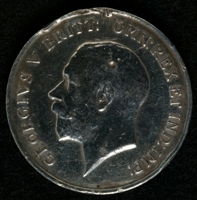

British War Medal
Charles was born on the 4th August 1895 in Oldham, Lancashire. His father was called Adam and his mother was Elizabeth. He was the youngest of 4 children; his siblings were Frederick, Sidney and Arabella. The family were members of the Wesleyan Church. Sadly, Elizabeth died between Charles' birth and 1901.
Adam was a beef butcher by trade. In 1891 he worked for someone else, but by 1901 he had opened his own shop at the family home, 37 Shaw Road in the Royton area of Oldham. Ten years later in 1911 he had moved his shop and his children to 26 Manchester Road.
In this year's Census Adam described himself as a 'Master Butcher'. Frederick and Charles assisted their father in his shop. Arabella looked after the house. Adam's brother Barraclough was living with them at this time. We don't know where Sidney was.
The First World War broke out in August 1914 and Charles joined the Army on the 12th November. He still lived and worked with his father. He enlisted in the Oldham Battalion of Comrades, which was being formed by the men of the town so that they could serve together.
When he enlisted Charles was 5 feet 7 1/8 inches tall and weighed 144 pounds. He had grey eyes and brown hair. The Oldham Battalion became the 24th Battalion of the Manchester Regiment and Charles was given the service number 14176. He was assigned to IV Platoon in A Company. On the 1st February 1915 Charles was promoted to Lance Corporal.
The 24th Battalion began life at Chadderton Hall Farm near Oldham (in 2013 a park). In early March 1915 the battalion moved to Llanfairfechan between Conwy and Bangor on the North Wales coast, and then moved again to Grantham, Lincolnshire 2 months later. They stayed there until September and then moved one last time to Larkhill in Wiltshire. From there Charles and the battalion moved to France on the 8th November.
During their first few months in France the 24th Battalion spent time holding the front line trenches around Albert and Arras, as well as being used as labour for various construction and excavation projects behind the lines. They saw some fighting, but were not involved in any large battles.
During May 1916 the 24th Battalion was given the new role of Pioneers. They would now focus on work such as digging trenches, building roads and buildings, and moving supplies. They were still equipped and trained to fight as infantry, but this was no longer their main role.
As Pioneers the battalion supported the Somme Offensive that began on the 1st July. They followed the attacking infantry and began to build new trenches and dug outs in captured areas.
After they left the Somme sector in September the 24th Battalion moved north to Armentieres near the Belgian border. Between the 23rd April and the 3rd May 1917 Charles was able to return to the UK on leave.
The battalion entered Belgium in June 1917 and were sent to Ypres (now called Ieper). Between June and October Charles and the 24th Battalion supported the Passchendaele Offensive fought in this area.
The 24th Battalion was withdrawn from Ypres in late October and sent to a completely different environment. They arrived in Italy in late December 1917. They had been sent, along with other British and French units, to help support the Italian Army in their fight against Austria-Hungary. The Italians had suffered a devastating defeat at the Battle of Caporetto the previous month, and were in danger of collapsing completely.
Charles' surroundings may have changed, but his job had not. Digging trenches was more challenging in the rock of the Asiago plateau than the mud of France and Flanders, although once built they needed less maintenance. Moving supplies up narrow, steep paths from the plains to the trenches 4,000 feet above was also a significant challenge. As compensation though, for Charles and his comrades the Italian front was generally quieter and more relaxed than France.
On the 30th July 1918 Charles either fell ill or was wounded. He was admitted to the 24th Casualty Clearing Station for treatment. After a week he was moved to the 62nd General Hospital at Bordighera on the Mediterranean coast near the French border. He was treated here until the end of September.
We believe Charles returned to the 24th Battalion and fought with them until the end of the war in Italy on the 4th November. He returned to the UK during February 1919 and was transferred to the Class Z Army Reserve at Prees Heath in Shropshire on the 22nd March.
The Class Z Reserve existed so that soldiers could be easily called back to the Army if fighting had broken out again. It was never needed.
Charles was discharged from the Reserve on the 6th August. The next day he joined the Royal Navy.
Charles was given the service number SS124290. His Rating, or trade, was Stoker, which meant he was responsible for keeping a ship's engines fed with coal. He was assigned to HMS Pembroke II, the official name for Chatham Dockyard and barracks, until the 3rd November.
On this date Charles was drafted to HMS Wryneck. This was a W Class Destroyer that had been completed on the last day of the war, the 11th November. Soon after he joined the Wryneck Charles was sent to the Baltic Sea.
The Russian Revolution of 1917 had led to a Civil War. The British were concerned about Communism, or Bolshevism as it was called, spreading into Europe. Latvia and Estonia had been part of the Russian Empire, but they had both declared independence since the revolution. They were now fighting the Russians.
The British fleet in the Baltic was used to prevent the Bolsheviks taking over Russian warships and putting to sea. They also shelled Bolshevik positions on land in support of Latvian and Estonian forces, and transported supplies to the two nations.
Later in 1919 the British also supported the White Russian forces, which were fighting the Bolsheviks, or Reds. On the 3rd February 1920 the Bolsheviks and Estonia signed the Treaty of Tartu, which recognised Estonia as an independent nation. The British fleet then withdrew.
Conditions for British sailors in the Baltic were difficult. Like Charles, many of them were veterans of the First World War, and wanted to go home. Their living conditions and food were of poor quality, and there was very little opportunity to go ashore on leave.
Charles left the Wryneck on the 3rd September 1920. He was drafted to HMS Columbine. This was the name of the Dockyard at Rosyth, near Edinburgh. Larger ships or shore bases would often 'look after' the administration of sailors serving on smaller vessels, so we don't know for certain which ships Charles served aboard during this period.
In April 1921 Charles was admitted to the City Fever Hospital in Edinburgh. We don't know what was wrong with him.
We don't know what happened to Charles. In October 1922 Adam was sent a form asking him to name all the living relatives of a soldier who had died. This was so that the man's medals would go to the correct person. This suggests Charles had died by then.
Charles' medal was donated to the Museum of the Manchester Regiment in July 1997. As well as his British War Medal, Charles was also awarded the 1914-15 Star and the Allied Victory Medal for his military service.




